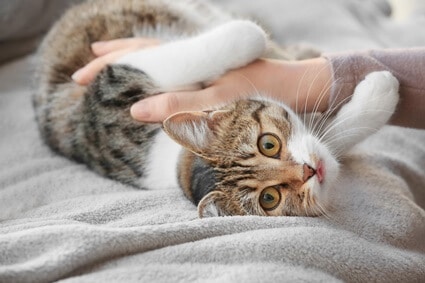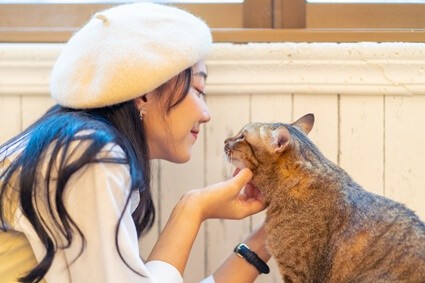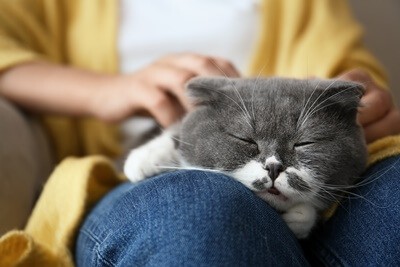Conventional wisdom dictates that a purring cat is a happy cat. It’s true that cats purr when contented. As cats enjoy being petted, the noise often accompanies stroking. Just be aware that this is not always the case.
Cats purr for two different reasons – pleasure and pain. Stroking your cat will initially release endorphins. Your cat may even grow so relaxed that it dozes off. You may be mistaking snoring for purring. Also, petting for too long can make a cat uncomfortable. At this point, your cat will purr to self-soothe in the face of discomfort.
Ceasing petting before it becomes painful means your cat will not bite your hand. Learning the body language associated with purring ensures that your cat will continue to enjoy physical interaction.
Why Do Cats Purr When Petted?
Purring is arguably a cat’s most common form of communication. Unlike other verbalizations, such as meows, cats also purr around their fellow felines. Purring comes in many forms. Telling these apart is key to understanding your cat.
As a cat is constantly purring, it will frequently purr while being stroked. Ideally, this means the cat is enjoying the fuss. The cat may be attempting to keep itself calm while confronting pain or fear, though. Despite most cats purring throughout the day, this remains a voluntary action.
According to Respiration Physiology, the neural oscillator sends messages to the laryngeal muscles. The larynx then opens and closes, separating the sound from the voice box. This enables a cat to purr, simultaneously making other sounds if desired.
Learn the feline body language that accompanies purring. Pay attention to other vocalizations that accompany purring, too. This will help you understand if your cat is enjoying being petted. If the cat is uncomfortable, biting and scratching will inevitably follow.
Happiness and Relaxation
Most of us assume that a purring cat is a contented and relaxed cat. In most cases, this is true. Cats learn to purr from an early age. Within a day or two of birth, kittens start to purr. This is a form of communication. The kitten is notifying its mother that it is close and safe.
Oftentimes, this will encourage the kitten’s mother to approach. A mother cat will ensure her cats are warm and fed. This releases endorphins in the kitten’s brain. It begins to equal purring with positive experiences.
If you have a strong bond with your cat, you will take on the role of its mother. Cats are independent animals, but they still need reassurance every now and again. If your cat purrs when you pick it up, it may be expressing approval. It is giving the OK to offer petting.
Cats also purr when in a state of blissful relaxation. If you pet your cat in a preferred spot, these feelings of contentment will be magnified. All cats have sweet spots where they love to be stroked. These include:
- Between the ears
- Under chin
- Alongside cheeks
- Along the spine, but this can lead to overstimulation
If your cat purrs while being petted in these places, it’s usually safe to assume it is happy. Contentment is the most common reason for feline purring. You can also watch your cat’s body language during this petting. If it displays the following, the cat is perfectly relaxed:
- The complete absence of tension in the body
- Limbs outstretched or curled in a loose ball
- Eyes closed or gently blinking
- Ears in a relaxed position that are pointing forward
- Tail still or curled upward, akin to a question mark
- Whiskers pointing away from the face
- Claws sheathed
- Leaning into the petting
In these cases, your cat’s purring is akin to a lullaby. The cat is so contented that it may fall asleep. At this point, the cat’s purr may start to change in speed and volume. If so, your cat may be snoring, not purring.

Is My Cat Purring or Snoring?
If your cat is asleep, it will not purr. As discussed, purring requires a conscious effort. If your cat is in a deep sleep, it will lack the ability to purr. It may be snoring, though. Feline snoring can sound similar to purring to the untrained ear.
Some cats are more prone to snoring than others. Snoring is most common in brachycephalic breeds, such as Persian, Burmese, and Himalayan cats. These cats have smaller nostrils, making breathing slightly more difficult while sleeping.
The main difference between purring and snoring is the pattern of sound. The volume and speed of the purring will remain consistent. If there are changes, they will be gradual and remain regular. Snoring will be more stop-start. It will typically be louder, too.
Another way to tell is by watching your cat. A cat will only snore if it is in a deep sleep. Some cats will merely doze while being petted. The stimulation of the petting will keep it awake. Signs that your cat is sleeping heavily include:
- Twitching ears
- Rapid pupil movement behind closed eyes
- Squeaks and other quiet noises
If this is the case, continue what you’re doing. Physical contact has helped your cat fall asleep, so ceasing petting may wake it up suddenly. This will disorientate the cat, which can lead to defensive aggression.
Pain and Discomfort
Pain and pleasure occupy differing ends of a cat’s stimulation spectrum. Unfortunately, they can both be identified through purring. It is important that you acknowledge your cat’s other behaviors while it purrs.
Self-soothing is the other main reason for a cat to purr, other than pleasure. Think of this purring as the equivalent of a deep breath while you are under duress. The cat is doing whatever it can to avoid demonstrating discomfort.
There are many reasons for a cat to be pained and uncomfortable during petting. You may be aggravating a pre-existing condition. The cat may loathe physical contact and is attempting to remain calm. Most often, the cat is overstimulated by the petting.
Overstimulation
All cat owners will experience a bite on the hand while petting on occasion. This is often inexplicable. One moment the cat is in your lap, purring contentedly while being petted. Then, without warning, it bites. This means the cat is overstimulated.
Cat skin is thin. This means that it can only withstand so much physical touch before it starts to hurt. Some cats will give warning signs of this. Others will react immediately.
Your cat’s purr is the first warning that your cat is growing overstimulated. The purr will be less gentle and quiet, becoming increasingly loud and abrasive. The cat is trying to remain calm. Other symptoms include:
- Fidgeting during petting
- Watching your hands carefully
- Growling or hissing
- Attempting to escape
- Swishing tail
- Ears flattening against the head
- Dilated pupils
As soon as you see these signs, stop the petting at once. Let the cat go. As far as the cat is concerned, it warned you that it was at breaking point. It will feel justified in biting if you continue petting.
Pre-Existing Pain
Your cat may have a pre-existing health condition that is causing pain. This is common in senior cats. Many older cats live with arthritis. The cat may have other infections and illnesses that cause physical discomfort. The cat will constantly purr to manage its pain.
Just because your cat is not crying, it does not mean it is comfortable. As per The Journal of Feline Medicine and Surgery, cats do not display overt signs of pain. This is a sign of weakness, from a cat’s perspective. Most cats in pain will display the following behaviors:
- Hiding from contact
- Uncharacteristic aggression
- Hunching and curling in a ball
- Refusing to groom
- Louder purring, alongside other atypical verbalizations
The cat may still tolerate petting in order to keep up appearances. The cat’s purring will be loud and aggravated, though. In this instance, cease the petting and investigate the root cause of the cat’s pain.
Bone and Muscle Healing
Your cat may also be purring to heal a previous injury. The cat may have a skeletal or muscular injury caused by an impact or fall. Cats can fall from a height without hurting themselves, but never make assumptions.
The Journal of the Acoustical Society of America explains how purring can heal bone injuries in cats. Purring at a frequency of 25 and 150 Hz creates vibrations that promote bone healing.
This, coupled with the self-soothing associated with purring, will temper any pain aggravated through touch.
If you have any reason to believe your cat may be injured, stop petting. Watch the cat from afar and look for signs of injury. As above, do not wait for the cat to tell you it is in pain. Look out for warning signs. These may also include limping.

Stress and Anxiety
Not all cats enjoy being handled by humans. Petting is done with the best of intentions, but you may be scaring your cat.
Some cats are naturally nervous and afraid of their own shadows. Such cats will always be wary of you. Do not take this personally. The cat just sees you as a much larger animal. Your ability to pick up the cat, and trap it within your arms, enhances this fear.
While you are stroking your cat, look at its body language. If you notice any of the following, your cat is stressed and afraid.
- Dilated pupils
- Ears flat against the back of the head
- Tense body
- Attempting to make the body as small as possible
Let the cat go at once. No amount of purring will improve the situation. The cat just wants to get away. Respect these wishes, and do not force petting upon the cat. In the future, let the cat approach you for attention. When it does so, offer petting in short, controlled bursts.
Hunger
Most cats enjoy being petted. They enjoy being fed more, though. It’s possible that your cat is purring to announce that it is hungry. Your cat may have approached you to convey this message. It will tolerate being petted instead, but eventually, patience will wear thin.
Of course, it is also possible that your cat was content with petting, to begin with. A cat’s priorities can change. After a while, the cat may decide it is now ready to eat. This is especially likely if you often pet your cat immediately before mealtimes.
Once you understand the sound of a hungry purr, you will always recognize it. Current Biology describes it as, “the cry embedded within the purr.” This purr will be louder, more dramatic, and less pleasant to the ear. It will sound less like a lullaby, more like a baby crying.
This is a deliberate act. Domesticated cats have long mastered the art of manipulating humans. Kittens learn that crying attracts the attention of their mothers, who quickly offer food and comfort. Once the cat leaves its mother, this becomes your responsibility.
Any kind of crying while purring is sending a message. Let your cat go at once. Watch what your cat does next. If hungry, the cat will likely approach an empty food bowl and meow.
Heavy Breathing
Ensure that you are not mistaking heavy breathing for purring. If your cat’s mouth is open, it is likely struggling for breath. This may need to be managed urgently.
Some senior cats lose their breath after short bursts of exercise, so do not immediately panic. If the cat approached you for petting after play, it wanted a break. The cat’s breathing should return to normal after a few minutes. At this point, the purring will continue.
If the cat continues to display harsh, labored breathing, a health concern is likelier. The purring will be due to the cat managing its own discomfort. A cat at rest, enjoying petting, should not breathe heavily for long.
There are many possible explanations for this. Not all of them involve a major health scare. Your cat may just have a minor respiratory infection. This can easily be resolved with a course of antibiotics.
The majority of the time, a cat purrs through contentment while being petted. Just make sure this remains the case. You want your cat to consider petting a source of pleasure, not fear or pain. If you have reason to suspect that purring is not announcing happiness, cease petting immediately.

